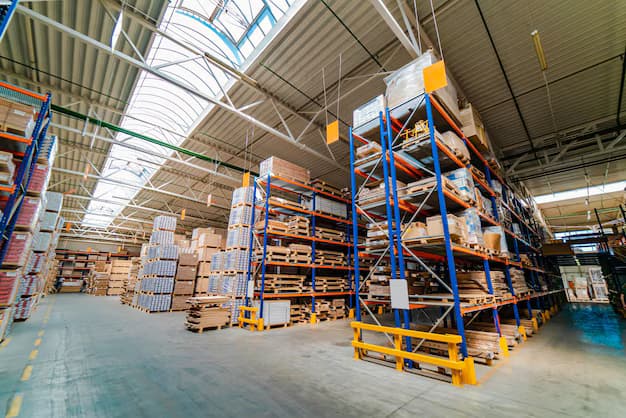Warehouse Racking System Designs For Maximum Space Utilisation
Efficient use of space is a critical factor in modern warehouse operations. With rising real estate costs and increasing inventory demands, businesses must maximize every square meter of their storage facilities. Implementing a well-designed warehouse racking system ensures optimal space utilisation, improved workflow, and enhanced operational efficiency. By carefully selecting and configuring racking systems, warehouses can store more inventory safely while maintaining accessibility and productivity.

Understanding Warehouse Racking Systems
Warehouse racking systems are structured frameworks designed to store pallets, bulk items, or goods efficiently. They provide vertical storage, improve organization, and facilitate easy access to inventory. Racking systems vary in design depending on storage requirements, product types, and operational workflows.
Common Types of Warehouse Racking Systems
Selective Pallet Racks: Offer direct access to every pallet, ideal for diverse inventory with varying turnover.
Drive-In and Drive-Through Racks: Maximise storage density for large volumes of homogeneous products.
Double-Deep Racks: Store pallets two deep, balancing storage density with accessibility.
Pallet Live Racking: FIFO systems that use gravity rollers to move pallets automatically.
Cantilever Racks: Suitable for storing long, bulky items such as pipes or timber.
Mezzanine Flooring with Racking: Combines vertical storage with intermediate office or storage floors to fully utilise warehouse height.
Designing a Warehouse Racking System
Assessing Warehouse Layout
Effective racking starts with a thorough assessment of the warehouse layout. Factors such as ceiling height, floor dimensions, column placement, and loading/unloading areas determine the optimal configuration for maximum space utilisation.
Determining Storage Needs
Understanding the type, size, and turnover of inventory is essential. High-turnover items may require easily accessible selective racks, while bulk or uniform products may benefit from drive-in or pallet live systems.
Planning Aisle Widths
Aisle widths must accommodate forklifts and pallet trucks while maximising storage density. Narrower aisles increase storage capacity but require careful consideration of operational safety and maneuverability.
Vertical Space Utilisation
Utilising the full height of a warehouse is key to maximising storage. Mezzanine floors or taller racking systems can add extra layers of storage without increasing the building footprint.
Load Capacity and Safety
Each rack must be designed to support the weight of stored goods. Proper load calculations, beam selection, and anchoring ensure structural stability and safety for both inventory and staff.
Benefits of Efficient Warehouse Racking System Design
Increased Storage Density
Well-planned racking systems allow more goods to be stored in the same area, optimising both floor space and vertical capacity.
Improved Inventory Accessibility
Strategically designed layouts ensure that all products are easily accessible, reducing handling time and improving operational efficiency.
Enhanced Workflow Efficiency
By aligning racking systems with warehouse processes, businesses can streamline loading, unloading, and stock rotation, reducing delays and operational bottlenecks.
Reduced Operational Costs
Optimised storage reduces the need for additional warehouse space and minimises the time spent retrieving inventory, lowering labor and overhead costs.
Safety and Compliance
A professionally designed racking system incorporates safety features such as pallet stops, safety bars, and adequate spacing to prevent accidents, ensuring compliance with warehouse safety standards.
Advanced Considerations for Modern Warehouse Racking
Automated Storage and Retrieval Systems (ASRS)
Integrating ASRS with racking systems allows for automated inventory handling, further increasing space utilisation and operational efficiency.
FIFO and LIFO Configurations
Selecting the correct system for stock rotation—FIFO for perishable items or LIFO for specific inventory management—optimises both storage and product lifecycle management.
Modular and Scalable Systems
Designing modular racking allows warehouses to adapt to changing inventory needs, expand capacity, or reconfigure layouts without major construction.
Integration with Technology
Using warehouse management systems (WMS) and inventory tracking software in combination with racking systems ensures optimal placement, stock control, and efficient retrieval.
Long-Term Impact of Effective Racking Design
A carefully designed warehouse racking system provides significant long-term benefits. Businesses can achieve higher storage capacity, faster order processing, improved safety, and better space utilisation. Over time, these advantages contribute to reduced operational costs, higher productivity, and enhanced warehouse performance.
Conclusion
Warehouse racking system design is crucial for maximizing space utilisation and operational efficiency. By selecting the right type of racks, optimising layouts, and considering future scalability, businesses can create safe, accessible, and highly efficient storage environments. For expert guidance in designing, installing, and optimising warehouse racking systems, Dalvie Systems provides professional solutions tailored to meet specific operational needs and maximise warehouse performance.